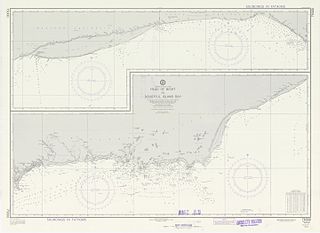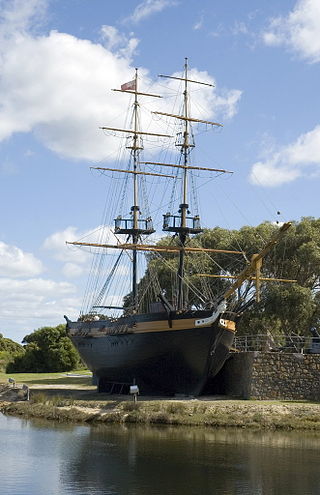Related Research Articles

James Weddell was a British sailor, navigator and seal hunter who in February 1823 sailed to latitude of 74° 15′ S—a record 7.69 degrees or 532 statute miles south of the Antarctic Circle—and into a region of the Southern Ocean that later became known as the Weddell Sea.

HMS Pandora was a 24-gun Porcupine-class sixth-rate post ship of the Royal Navy launched in May 1779. The vessel is best known for its role in hunting down the Bounty mutineers in 1790, which remains one of the best-known stories in the history of seafaring. Pandora was partially successful by capturing 14 of the mutineers, but wrecked on the Great Barrier Reef on the return voyage in 1791. HMS Pandora is considered to be one of the most significant shipwrecks in the Southern Hemisphere.
Over 1400 ships have been wrecked on the coast of Western Australia. This relatively large number of shipwrecks is due to a number of factors, including:

Astrolabe was originally a horse-transport barge converted into an exploration ship of the French Navy. Originally named Coquille, she is famous for her travels with Jules Dumont d'Urville. The name derives from an early navigational instrument, the astrolabe, a precursor to the sextant.

The Archipelago of the Recherche, known locally as the Bay of Isles, is a group of 105 islands, and over 1200 "obstacles to shipping", off the south coast of Western Australia. The islands stretch 230 km (140 mi) from east to west and to 50 km (31 mi) off-shore encompassing an area of approximately 4,000 square kilometres (1,544 sq mi). The western group is near Esperance and the eastern group at Israelite Bay. They are located in coastal waters, part of which is designated the Recherche Archipelago Nature Reserve.
Margaret was a British-built Australian brig that was launched in 1799 and wrecked in 1803.
Betsey was a ship that was launched at Chittagong in 1803. She was abandoned off the coast of New Zealand in 1815.
His Majesty's colonial brig Elizabeth Henrietta was completed in 1816 for New South Wales service, but capsized on the Hunter River, Australia later that year with the loss of two lives. The ship was wrecked in 1825.
Trial was a ship that first appears in Australian newspaper records in 1808 and that was seized by convicts and eventually wrecked on the Mid North Coast of New South Wales, Australia in 1816.
Wreck Island is a small coral cay. It is located near the Tropic of Capricorn in the southern Great Barrier Reef, 93 km due north east of Gladstone, Queensland, Australia, and 460 km north of the state capital Brisbane.

Amity was a 148-ton brig used in several notable voyages of exploration and settlement in Australia in the early nineteenth century.
Admiral Gifford was a wooden schooner that was lost while travelling between Port Macquarie and Sydney, New South Wales, on 8 October 1834 with a cargo of grain, hides and tallow.
Sun was a brig built in 1819 at Sunderland and was condemned at the Cape of Good Hope in August 1822. She was repaired and began sailing east of the Cape. She was wrecked in May 1826 in the Torres Strait.
Matthew Brisbane was a Scottish mariner, sealer and notable figure in the early history of the Falkland Islands.

Iserbrook was a general cargo and passenger brig built in 1853 at Hamburg (Germany) for Joh. Ces. Godeffroy & Sohn. It spent over twenty years as an immigrant and general cargo vessel, transporting passengers from Hamburg to South Africa, Australia and Chile, as well as servicing its owner's business in the Pacific. Later on, the vessel came into Australian possession and continued sailing for the Pacific trade. In 1878 it caught fire and was sunk the same year. At last, it was re-floated and used as a transport barge and hulk in Sydney until it sank again and finally was blown up.

Middle Island is an island off the south coast of Western Australia in the Recherche Archipelago, around 120 km (75 mi) south-east of Esperance. It is known for its pink lake, Lake Hillier. Goose Island lies just adjacent to the north.
Calder was a brig launched in 1821 at Calcutta. A new owner in 1822 sailed her to Australia and she then traded in the Pacific until in 1825 she sailed to Chile and was wrecked at Valparaiso. There a new owner salvaged her and returned her to sailing under the name Indefatigable. On Indefatigable's first voyage the Chilean members of her crew mutinied, killing her captain. The mutineers sailed to Guam where the authorities took Indefatigable in prize. She was later lost in a typhoon in the China Sea.
Nassau was launched at Gosport in 1819. In 1824 a pirate plundered her, and then let her proceed. She was wrecked in August 1825 as she was on her way back to London from a voyage to New South Wales.
References
- 1 2 Australian Shipwrecks – vol1 1622–1850, Charles Bateson, AH and AW Reed, Sydney, 1972, ISBN 0-589-07112-2, p. 66
- ↑ "Belinda | Maritime Archaeology Databases".
- ↑ The Sydney Gazette and New South Wales Advertiser, 15 Apr 1826, p. 1